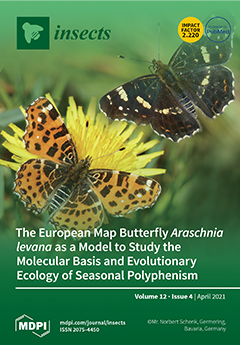Glyphodes pyloalis Walker (
G. pyloalis) is a serious pest on mulberry. Due to the increasing pesticide resistance, the development of new and effective environmental methods to control
G. pyloalis is needed. Trehalase is an essential enzyme in trehalose hydrolysis and energy supply, and it has been considered a promising target for insect pest control. However, the specific function of
trehalase in
G. pyloalis has not been reported. In this study, two trehalase genes (
GpTre1 and
GpTre2) were identified from our previous transcriptome database. The functions of the
trehalase in chitin metabolism were studied by injecting larvae with dsRNAs and trehalase inhibitor, Validamycin A. The open reading frames (ORFs) of GpTre1 and GpTre2 were 1,704 bp and 1,869 bp, which encoded 567 and 622 amino acid residues, respectively. Both of
GpTre1 and
GpTre2 were mainly expressed in the head and midgut. The highest expression levels of them were in 5th instar during different development stages. Moreover, knockdown both of
GpTre1 and
GpTre2 by the dsRNAs led to significantly decreased expression of chitin metabolism pathway-related genes, including
GpCHSA,
GpCDA1,
GpCDA2,
GpCHT3a,
GpCHT7,
GpCHSB,
GpCHT-h,
GpCHT3b,
GpPAGM, and
GpUAP, and abnormal phenotypes. Furthermore, the trehalase inhibitor, Validamycin A, treatment increased the expressions of
GpTre1 and
GpTre2, increased content of trehalose, and decreased the levels of glycogen and glucose. Additionally, the inhibitor caused a significantly increased cumulative mortality of
G. pyloalis larvae on the 2nd (16%) to 6th (41.3%) day, and decreased the rate of cumulative pupation (72.3%) compared with the control group (95.6%). After the activities of trehalase were suppressed, the expressions of 6 integument chitin metabolism-related genes decreased significantly at 24 h and increased at 48 h. The expressions of
GpCHSB and
GpCHT-h, involved in chitin metabolism pathway of peritrophic membrane in the midgut, increased at 24 h and 48 h, and there were no changes to
GpCHT3b and
GpPAGM. These results reveal that
GpTre1 and
GpTre2 play an essential role in the growth of
G. pyloalis by affecting chitin metabolism, and this provides useful information for insect pest control in the future.
Full article






